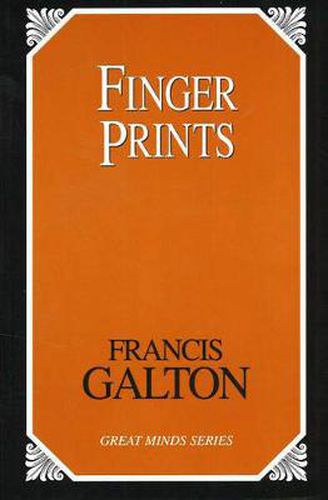Readings Newsletter
Become a Readings Member to make your shopping experience even easier.
Sign in or sign up for free!
You’re not far away from qualifying for FREE standard shipping within Australia
You’ve qualified for FREE standard shipping within Australia
The cart is loading…






Despite the increasing use of DNA evidence and other sophisticated forensic techniques in crime solving, fingerprints still serve as an indispensable tool of modern-day criminal investigation. This fascinating book, originally published in 1892, represents the first thorough investigation of this anatomical peculiarity and its application in establishing individual identity for use in law enforcement. Sir Francis Galton, a cousin of Charles Darwin and a member of the Royal Geographical Society, had already made a reputation for himself as an explorer of Africa and the founder of the new field of eugenics when he turned his attention to the subject of fingerprints. Through extensive research at his ‘anthropometric laboratory’, Galton laid out an elementary system of classifying fingerprints based on observed patterns of arches, loops, and whorls. Using meticulous drawings as well as photographs of ink prints, he showed that the numerous bifurcations, origins, islands, and enclosures in the ridges that compose the pattern, are proved to be almost beyond change. Thus, he established a sure method of individual identification. Galton’s system was later modified by Sir Edward R Henry, who became chief of police in London. In 1901, Scotland Yard officially adopted the Galton-Henry system of fingerprinting. Today, it is the most widely used system of fingerprint classification in the world. This classic work will make a welcome addition to the libraries of historians, criminologists, and fans of true crime and forensic science.
$9.00 standard shipping within Australia
FREE standard shipping within Australia for orders over $100.00
Express & International shipping calculated at checkout
Despite the increasing use of DNA evidence and other sophisticated forensic techniques in crime solving, fingerprints still serve as an indispensable tool of modern-day criminal investigation. This fascinating book, originally published in 1892, represents the first thorough investigation of this anatomical peculiarity and its application in establishing individual identity for use in law enforcement. Sir Francis Galton, a cousin of Charles Darwin and a member of the Royal Geographical Society, had already made a reputation for himself as an explorer of Africa and the founder of the new field of eugenics when he turned his attention to the subject of fingerprints. Through extensive research at his ‘anthropometric laboratory’, Galton laid out an elementary system of classifying fingerprints based on observed patterns of arches, loops, and whorls. Using meticulous drawings as well as photographs of ink prints, he showed that the numerous bifurcations, origins, islands, and enclosures in the ridges that compose the pattern, are proved to be almost beyond change. Thus, he established a sure method of individual identification. Galton’s system was later modified by Sir Edward R Henry, who became chief of police in London. In 1901, Scotland Yard officially adopted the Galton-Henry system of fingerprinting. Today, it is the most widely used system of fingerprint classification in the world. This classic work will make a welcome addition to the libraries of historians, criminologists, and fans of true crime and forensic science.